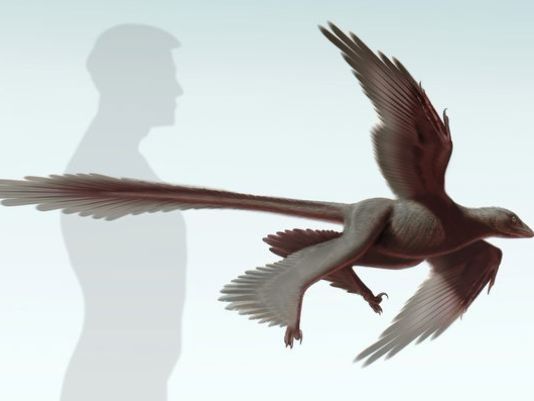
The discovery of a new species of prehistoric flying dinosaur in China could pave the way for scientists to find out more about the evolution of birds and how they learnt to fly.
The dinosaur, named Changyuraptor, evidently had four wings and a tail, measuring up to 30 centimetres in length. This is the longest tail ever to be found in a fossilized dinosaur. This bird-dinosaur also had feathers on its wings and tail. The scientists believe that these feathers must have played a huge part in the flight controls of the dinosaur, as it is one of the biggest prehistoric creatures to have ever taken flight. The details about the Changyuraptor have been published in an issue of Nature Communications.
"At a foot (30 centimetres) in length, the amazing tail feathers of the Changyuraptor are by far the longest of any feathered dinosaur," said Luis Chiappe of the National History Museum, Los Angeles.
The fossil, in which the huge flying dinosaur has been found, is around 123 million years old. It shows that the dinosaur was completely covered with feathers, including those attached to its hind legs, which gives the impression of a second pair of wings.
Until now, the largest four-winged dinosaur to be uncovered was the Microraptor Zhaoianus. The Changyuraptor however, was 60 per cent larger than the Microraptor Zhaoianus, and is now the largest flying raptor known to mankind.
The Velociraptor, which became world-famous through the movie series Jurassic Park by Steven Spielberg, is believed to be a distant relative of this dinosaur. Scientists have also found that Changyuraptor is even related to Tyrannosaurus Rex, which also made famous through the Spielberg series.
Also known as Chyangyuraptor Yangi, the massive bird dinosaur stood at 1.3 metres, and weighed around 40 kilograms.
"The new fossil documents that dinosaur flight was not limited to very small animals but to dinosaurs of more substantial size," said Chiappe. "Clearly, far more evidence is needed to understand the nuances of dinosaur flight, but Changyuraptor is a major leap in the right direction."
Scientists have always been intrigued by the origin of land animals' flying and how that has evolved in time. Before the discovery of Changyuraptor, the distinction of being the first bird dinosaur went to Archaeopteryx, the fossilized remains of which have been found in the limestone quarries of Germany.
The Archaeopteryx is said to be 150 million years old. However, last year, more remains of a creature were found, which seemed to be a close relative of the German bird dinosaur. These remains were 160 million years old. Now, with the discovery of the Changyuraptor, the picture is much clearer on who is winning the title of the oldest bird dinosaur to be discovered.

















